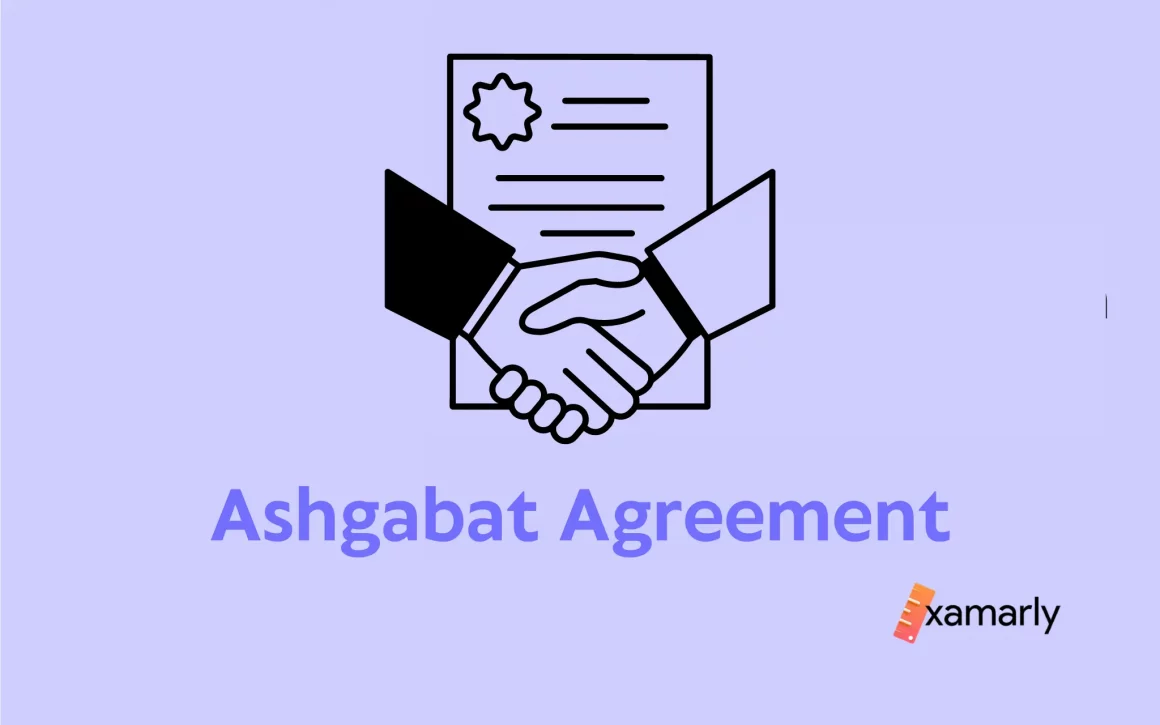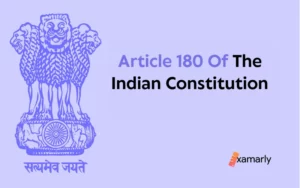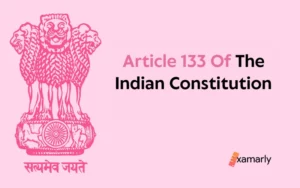The Ashgabat Agreement was signed in 2011, establishing an international transit and transport corridor between the countries involved. Its goals are to improve connectivity between these regions and facilitation of transit, trade, and cargo. India has recently become a signatory to the Ashgabat Agreement.
In this article, we will discuss the importance of the Ashgabat Agreement, as well as its key provisions.
The Ashgabat Agreement is a significant topic for the IAS Exam and is covered in UPSC Mains GS Paper II (International Relations and Indian Polity.)
- What is Ashgabat Agreement?
- Members of the Ashgabat Agreement
- Objectives of the Ashgabat Agreement
- Importance of this Agreement for India
- Ashgabat Agreement Connectivity
- International North-South Transit Corridor
- Relevance of INSTC to India (Economic and Strategic Dimensions)
- International North-South Transport Corridor (INSTC) – Role of India
- Eurasian Railway Connectivity
- Chabahar-Afghanistan
- Duration and Termination of this Agreement
- Conclusion
- FAQs on Ashgabat Agreement
What is Ashgabat Agreement?
The Ashgabat Agreement can be defined as a multimodal transportation agreement that takes into account the creation of an international transport and transit corridor linking the Persian Gulf and Central Asia. Road, rail, and maritime transportation will all be included in the multimodal corridor.
This agreement aims to create the quickest commercial route possible between the countries of Central Asia and the Iranian and Omani ports.
The trade agreement specifies a transit route through Iran, Turkmenistan, Kazakhstan, and Uzbekistan on the way to Oman and the Persian Gulf.
This would connect parts of the Middle East with Central Asia.
- It is a multimodal transport agreement involving the Persian Gulf and Central Asia.
- The Ashgabat Agreement has four original signatories. They are Iran, Turkmenistan, Oman, and Uzbekistan.
- The goal of this agreement is to establish the quickest trade path feasible between the nations of Central Asia and the ports of Iran and the Sultanate of Oman.
- Kazakhstan became a signatory in February 2018, and this agreement is expected to continue to be revised as needed.
- In addition to easing trade barriers, the Ashgabat Agreement will simplify procedures for the movement of goods between signatory nations. Ashgabat Agreement’s Contribution to the Development of Transportation:
- A rail link connecting Turkmenistan, Afghanistan, and Tajikistan was built in 2013.
- A transportation route connecting Azerbaijan, Turkmenistan, Turkey, Afghanistan, and Georgia was built in 2014.
- The Iran-Turkmenistan-Kazakhstan (ITK) rail project was started.
Members of the Ashgabat Agreement
The four founding members of the agreement—Iran, Oman, Turkmenistan, Qatar, and Uzbekistan—signed the original agreement on April 25, 2011, with the intention of creating a trade and transportation corridor between them.
Later, in 2013, Qatar retracted the contract. That same year, Kazakhstan filed a membership application, which was later approved in 2015.
In addition to the Lapis Lazuli corridor, Pakistan officially joined the Ashgabat Agreement in October 2016. Kazakhstan is also included in the agreement.
India joined this agreement under the PM of India, Narendra Modi, on February 1, 2018, which calls for the construction of a global transportation and transit route or corridor connecting Central Asia with the Persian Gulf in order to considerably increase trade and investment.
Objectives of the Ashgabat Agreement
- The Ashgabat Agreement aims to create an integrated transport and trade corridor, thereby increasing trade and lowering barriers to travel.
- It will also facilitate cargo transit, trade, and communication between the signatory countries. This will also help to synchronize the International North-South Transport Corridor.
- The only goal of this contract is to create a corridor for trade and transport by creating the shortest possible commercial interaction between the Central Asian Republics or Central Asian Countries and the Persian Gulf
Importance of this Agreement for India
- In 2015, the Indian government announced the National Policy on Integrated Transport to strengthen connections on the International North-South Transport Corridor.
- It will enable India to improve trade and commerce with the Eurasian region. This can be done by utilizing an existing transportation and transit corridor.
- Without India’s participation in a Central Asian-led transport hub for north-south connectivity projects, it would not have been possible for India to establish the 610 km north-south railway link from Chabahar to Zahedan or operate a multi-purpose terminal at Chabahar.
- The relationship between India and Turkmenistan is crucial to India’s ‘Connect Central Asia’ project.
- India will have the option to divert cargo from the conventional marine channels to the transcontinental land transport element.
Ashgabat Agreement Connectivity
The Ashgabat Agreement is a significant step toward increased interconnection between nations, which will ultimately be advantageous to all participating nations.
The Ashgabat Agreement also provides for the free movement of people and goods across borders, allowing for increased trade and commerce. This is a win-win situation for the countries involved. This is particularly true for the nations that lack connectivity among themselves.
India can expand its commercial and economic relations with these countries through Ashgabat connectivity options and thereby produce a positive influence. It would also be beneficial for regional and international security.
The Ashgabat Agreement is a landmark step toward making connectivity easier for Indian businesses.
International North-South Transit Corridor
The Ashgabat Agreement will link the International North-South Transport Corridor (INSTC), allowing simple freight transportation between Russia, India, Europe, Iran, and Central Asia. This is accomplished by combining ship, rail, and road connections.
The main route comprises moving commodities mostly from Russia, India, Iran, and Azerbaijan by boat, train, and road.
The INSTC envisions goods being transported by sea from Mumbai (India) to Bandar
Abbas (Iran), by road from Bandar Abbas to Bandar-e-Anzali (an Iranian port on the Caspian Sea), by ship from Bandar-e-Anzali to Astrakhan (a Caspian port in the Russian Federation), and by rail to areas of the Russian Federation and farther into Europe from Astrakhan.
Relevance of INSTC to India (Economic and Strategic Dimensions)
- To carry commodities to Russia, India must currently rely on the sea route via Rotterdam to St. Petersburg, as well as increasingly through China and then inland.
- With the INSTC, shipping goods from India to Eurasia and the surrounding areas would be substantially less expensive.
- According to certain assessments, the INSTC will reduce transit time and cost, allowing for the seamless movement of commodities from India to Russia and neighboring nations.
- Estimates indicate that compared to the current route from St. Petersburg to Moscow, the corridor would be 30% less expensive and 40% shorter.
- The region has access to potash. Other fertilizer inputs are also available.
- In particular, these nations stand to gain significantly from India’s expertise in digital technologies and IT-enabled services.
- Being one of the world’s largest consumers of energy, India’s energy needs could be satisfied by the abundance of natural resources in Central Asia, including uranium, natural gas, and petroleum.
- In line with the Connect Central Asia Policy, the INSTC will deepen our ties with Central Asia.
- Along with the INSTC’s beginning, the Belt and Road Initiative (BRI), a massive project involving 68 countries in Asia, Europe, and Africa, is reshaping international trade norms in China’s favor.
International North-South Transport Corridor (INSTC) – Role of India
- The enormous extent of India’s customs cooperation agreement with Iran needs to be expanded. This would enable transit to the Caspian Sea and other Central Asian nations via Iran.
- The easing of sanctions on Iran has given investors several opportunities to complete the INSTC’s gaps. This was previously impractical.
- The objective now should be to ensure that this development is completed as soon as possible. India has earlier pledged a $100 million investment for the building of a free trade zone in Chabahar, Iran.
- There is a compelling political and economic argument for India to devote greater political resources to improving access to the INSTC and establishing a link with Iran.
- India may create a forum for Central Asia similar to the one it has with Africa.
- The Shanghai Cooperation Organization (SCO) has developed into a potent regional alliance in Eurasia. India should take the initiative to engage with it.
Eurasian Railway Connectivity
This agreement will make use of the Turkmenistan-Afghanistan-Tajikistan (TAT) rail line from 2013, the Afghanistan-Turkmenistan-Azerbaijan-Georgia-Turkey transportation corridor in 2014, the Iran-Turkmenistan-Kazakhstan railroad, as well as TRACECA (Transport Corridor Europe Caucasus Asia), which links the EU with 14 Eastern European, South Caucasian, and Central Asian nations.
Chabahar-Afghanistan
India finalized its plan to construct a 900-km railway connecting Afghanistan’s Hajigak area with Iran’s Chabahar Port at Shahid Beheshti terminal earlier in 2011. The agreement was first signed in 2015 between the three countries. By removing the necessity for both nations to pass via Pakistani territory in 2017, the Chabahar Port of Iran facilitated trade between India and Afghanistan.
Duration and Termination of this Agreement
The Ashgabat Agreement will be in existence for ten years, after which it will be automatically extended. The agreement will, however, become invalid after a year if any participant sends the others a written notice of their intention to cancel it.
Conclusion
Enhanced connectivity is essential for trade and transportation, and this agreement is a silver lining for all countries in the region. It has opened up the sea, air, and road route to facilitate trade, especially for nations that had been unable to access Eurasia directly.
FAQs on Ashgabat Agreement
What is the capital of Turkmenistan?
Ashgabat is the capital of Turkmenistan.
Which countries are members of the Ashgabat Agreement?
India, Iran, Kazakhstan, Oman, Pakistan, Turkmenistan, and Uzbekistan are members of the Ashgabat Agreement.
Which nations comprise the founding member states of INSTC?
These are India, Iran, and Russia being the huge network of north-south connectivity projects.






